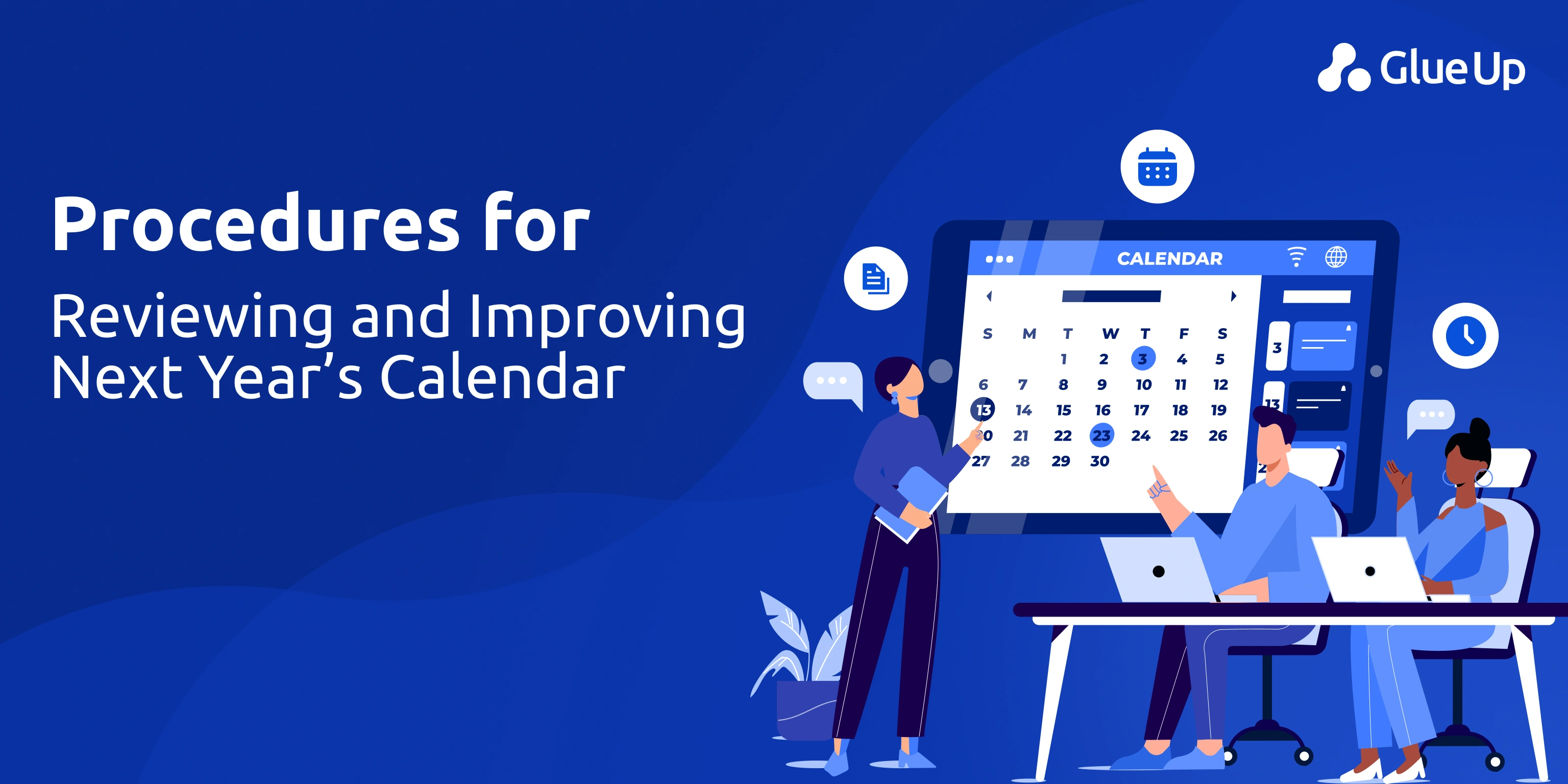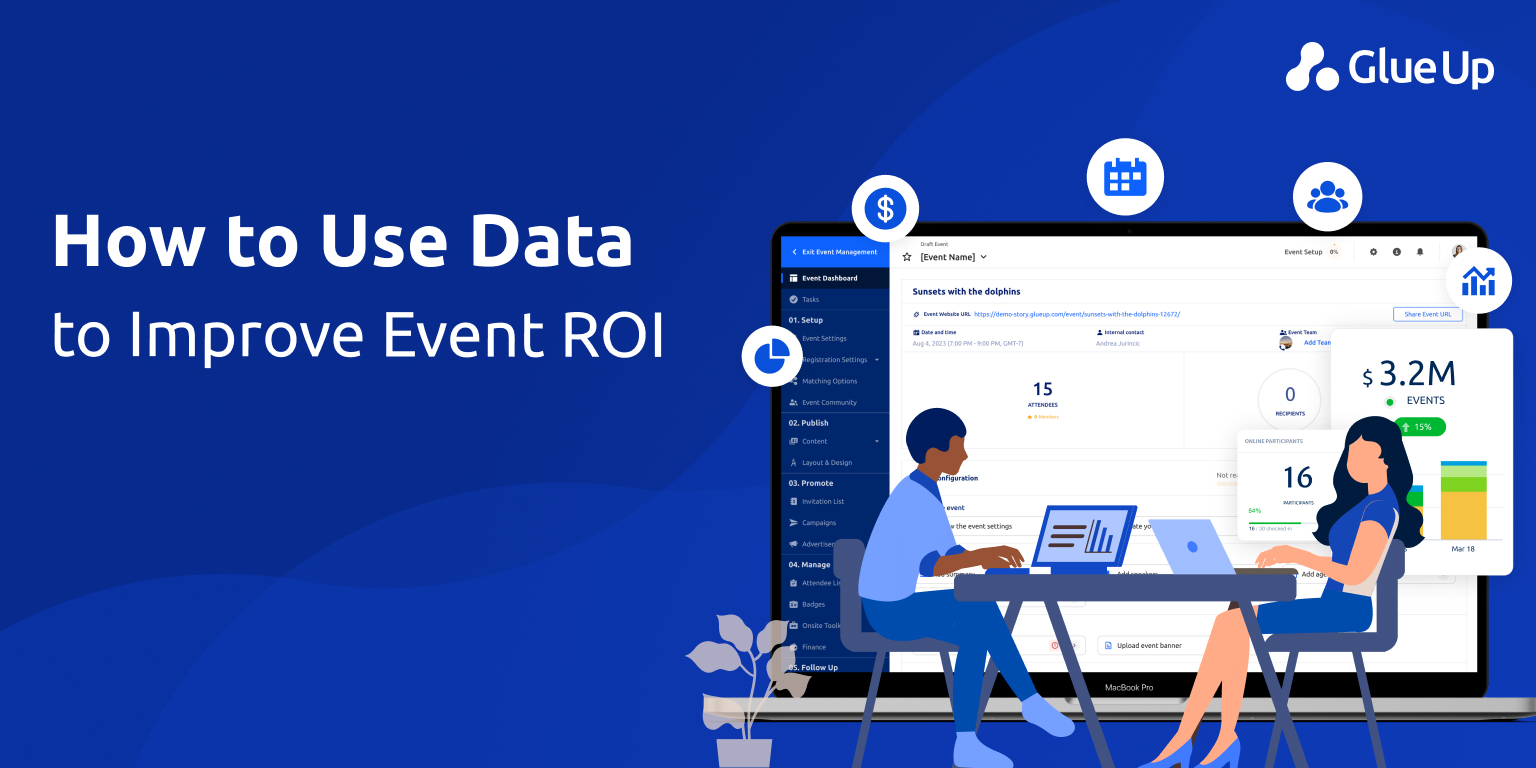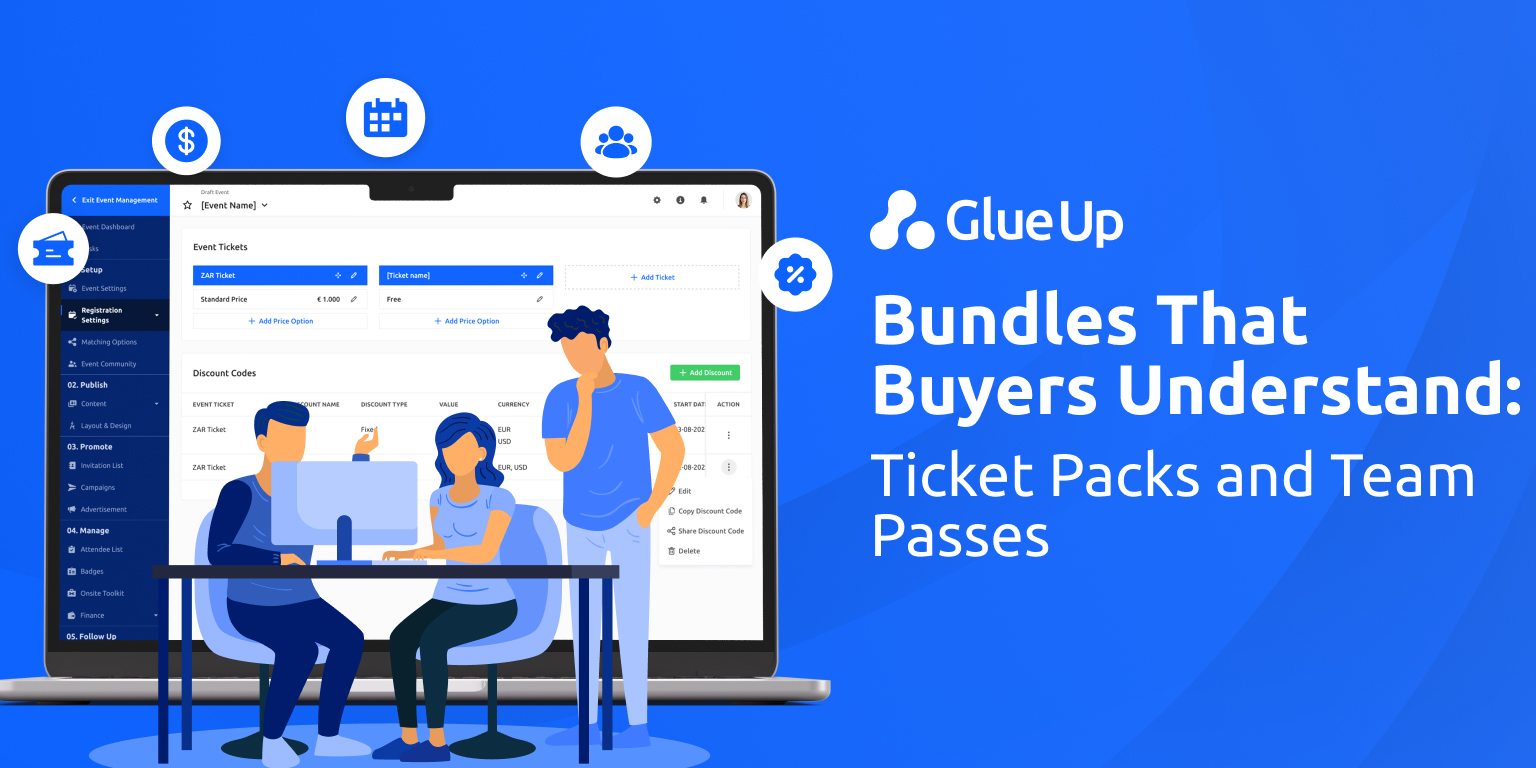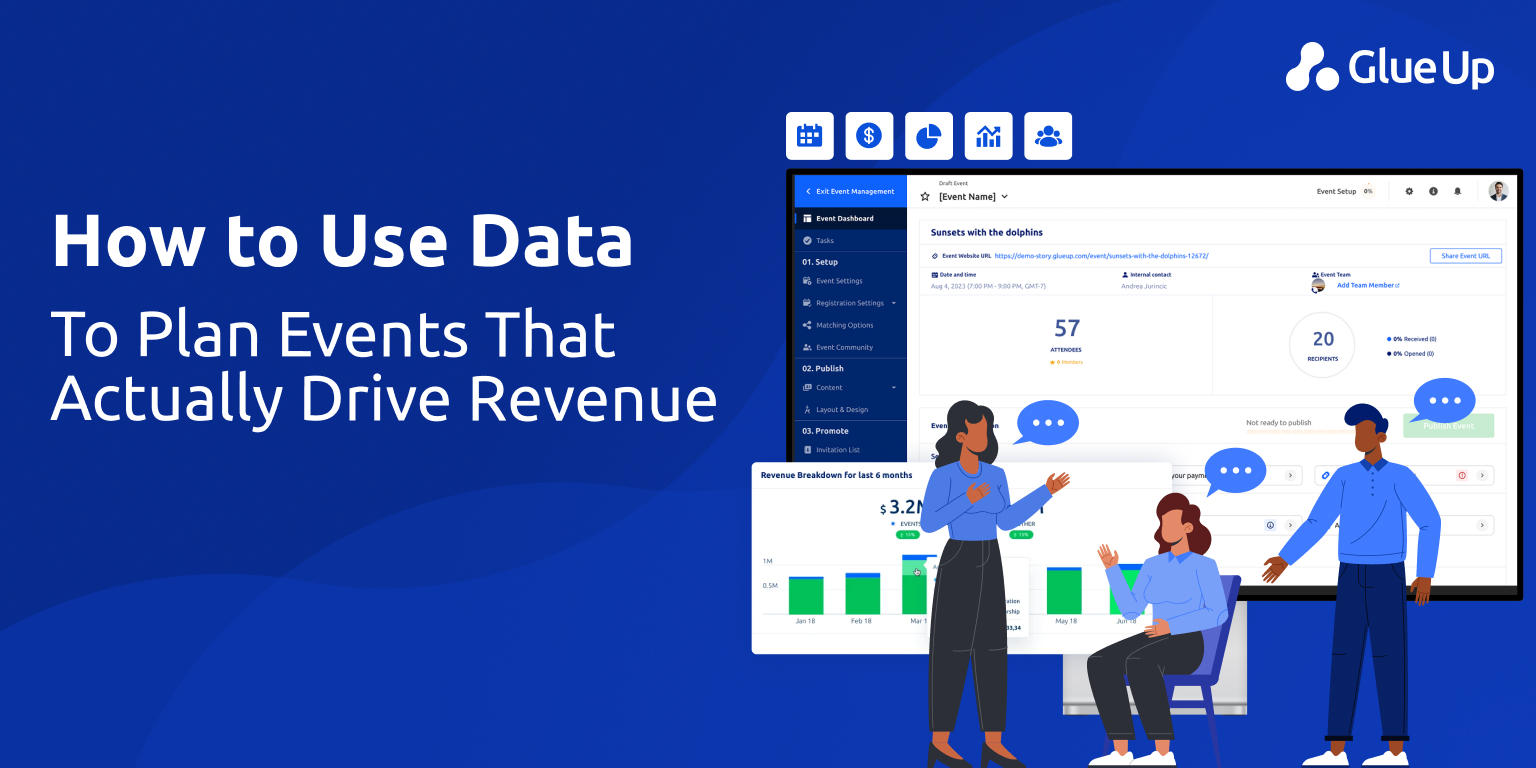
Most organizations treat event planning as a deadline-driven process when it should function as a continuous cycle of improvement. The difference between good and exceptional event programs lies in how you review and redesign your annual event calendar before the next fiscal year begins. According to Swoogo, organizations that leverage event analytics improve attendance retention and sponsorship ROI by more than 25%. That advantage compounds every year when planning becomes proactive, not repetitive.
Glue Up’s event management software helps you get there by connecting your calendar, event data, and workflows in one unified system. You can analyze performance, optimize scheduling, and align your team using AI-driven insights. The outcome is a predictable, data-backed strategy that scales engagement and drives measurable event ROI.
But before we get into how Glue Up makes that process seamless, let’s look at what proactive event calendar management actually means, and how it transforms future event planning into a strategic growth discipline.
Or, you can skip the read and speak to one of our experts while seeing our all-in-one event platform.
Key Takeaways
- Proactive event calendar management turns annual scheduling into strategic foresight.
Reviewing past event performance ensures next year’s calendar is built on data, not assumptions.
Integrating event dashboards and workflows improves collaboration and predictability.
Automation enables faster planning cycles and better alignment with strategic goals.
Glue Up’s event management software connects your entire event lifecycle in one intelligent system.
Rethinking Event Planning: From Scheduling to Strategic Foresight
If you want your events to grow in impact, you can’t treat your annual calendar as a routine checklist. Proactive event calendar management means using performance data, automation, and structured reviews to plan intelligently. Instead of repeating last year’s schedule, you evaluate what worked, what didn’t, and how each event contributes to measurable growth in attendance, engagement, and revenue.
By connecting your event management software, finance systems, and member engagement tools, you create a planning ecosystem that builds on evidence rather than memory. Every future event becomes a strategic asset that serves your mission and advances your business objectives.
Shift from Calendar Maintenance to Data-Driven Planning
You can’t improve what you don’t measure. That’s why you should approach next year’s calendar as a performance review, not a list of dates. Event analytics help you identify which programs deliver the strongest ROI and which require redesign. According to Forbes, organizations that use structured event data make faster, more accurate planning decisions and see stronger year-over-year results.
With Glue Up, you can review attendance analytics, sponsorship data, and engagement trends in one unified dashboard. This gives you a clear picture of your strongest-performing programs and a factual basis for future event planning.
Read More: Strategic Event Planning Guide for 2026
Treat Your Annual Event Calendar as a Strategic Asset
Your annual event calendar should work like a portfolio. In the association space, every event has a purpose, a measurable return, and a target audience. So, when you view your calendar this way, you can identify which programs drive the highest engagement, retention, and sponsorship ROI.
As Cvent notes, organizations that align event objectives with measurable outcomes achieve greater ROI and resource efficiency. That means planning your events around strategic goals, such as member growth, partner visibility, or policy influence rather than defaulting to what’s familiar.
Use Event Workflows to Build Predictability
If you’re managing logistics, sponsorships, and registrations across disconnected systems, you’re creating avoidable risk. Automating your event workflows ensures that tasks, approvals, and communication stay in sync across teams.
Glue Up connects your workflows, finances, and attendee engagement data in a single platform. You can track every part of your event lifecycle —from registration to post-event surveys —without duplication or manual reconciliation. This kind of automation improves planning accuracy and gives you a consistent operational rhythm.
Audit Before You Act: Reviewing This Year’s Performance with Precision
Before you plan next year’s events, you need to evaluate this year’s performance with structure and purpose. A precise audit helps you understand what worked, what underperformed, and what deserves more investment. This is the first principle of proactive event calendar management — knowing where your time and budget actually created impact.
An effective review doesn’t start with opinions. It starts with data. You should use event dashboards, post-event reports, and feedback analytics to identify patterns that shape smarter decisions. Event intelligence replaces guesswork with evidence, giving your leadership team clarity on what to repeat, refine, or retire.
Evaluate Attendance and Engagement Metrics
Attendance alone does not define success. You need to evaluate how participants engaged before, during, and after your programs. Review registration data, session participation, and engagement heatmaps to determine which formats held attention and which lost it.
With our all-in-one event software, you can analyze attendance by member type, region, and engagement level so that you can refine future event targeting.
Analyze Sponsorship and Financial Contribution
Every event influences your revenue model. Review which programs generated strong sponsorship renewals or new leads and which fell short of expectations. Use your event management software to connect these metrics with your financial dashboards, so you can see how sponsorships, ticketing, and donations contribute to your broader goals.
Integrating event data with your finance tools gives you an end-to-end view of profitability. You can identify which sponsorship packages or event categories drive the highest ROI and adjust your pricing or structure accordingly.
Review Post-Event Feedback and Survey Results
Your post-event surveys are more than administrative tasks; they are data pipelines for improvement. Review satisfaction scores from attendees, speakers, and staff to identify consistent feedback themes. As SurveyMonkey’s event insights note, survey data provides the most direct measure of attendee sentiment and content relevance.
Glue Up’s survey and event reporting features allow you to connect feedback to real event metrics, revealing how satisfaction correlates with attendance and engagement. This connection helps you prioritize programming changes and allocate resources to the events that deliver the most value.
Identify Timing, Frequency, and Resource Gaps
Once you understand what worked, review when it worked. Event timing and frequency play a critical role in attendance and satisfaction. Analyze when registrations peak, which days perform best for webinars or hybrid events, and which times of year create scheduling conflicts.
Associations that monitor calendar cadence often see stronger retention because they balance frequency with quality. Your annual event calendar should reflect your members’ behavior patterns, not your internal habits.
Align Your Review With Next Year’s Goals
The purpose of this audit is not just to report but to realign. Link your insights to strategic objectives for the coming year, whether it’s increasing attendance, expanding sponsorship, or enhancing member engagement. This ensures that next year’s planning cycle starts with clear direction, measurable targets, and validated data.
A strong review gives you more than a report. It gives you foresight. When your analysis integrates with your software, you can forecast participation, budget more accurately, and build an event plan rooted in performance rather than assumptions.
Build Improvement Cycles into Future Event Planning
Every future event plan should begin with analysis. Reviewing your current-year performance through dashboards, surveys, and feedback gives you the insight to refine your next cycle. This review process transforms event planning into a continuous-improvement discipline that compounds efficiency and engagement year after year.
Harvard Business Review emphasizes that organizations that close their learning loops through data gain measurable advantages in innovation and responsiveness. The same principle applies to your future event planning; each iteration becomes more aligned with audience needs and financial goals.
When you plan proactively, your events stop being reactive calendar entries and start functioning as strategic growth instruments. With the right tools and data visibility, you can anticipate performance, allocate resources effectively, and build an event strategy that’s both scalable and measurable.
Building Next Year’s Event Calendar with Predictive Insight
Once you complete your event review, the next step is to build an informed plan for the year ahead. The goal is not to replicate what worked but to design a smarter, data-backed calendar that anticipates outcomes and improves efficiency. This is where proactive event calendar management transitions from theory to practice.
With the right event management software and analytical workflows, you can forecast attendance, streamline collaboration, and optimize your event calendar for performance and predictability.
Use Historical Data to Shape Future Planning
Your best indicator of success is already in your data. Review engagement rates, attendance patterns, and post-event feedback to identify consistent performance trends. As Event Manager Blog
points out, organizations that use data-driven planning see measurable improvements in engagement and event ROI.
Glue Up simplifies this process by bringing together attendance data, feedback, and financial metrics into one dashboard. This allows you to compare year-over-year trends and forecast participation for upcoming events with greater accuracy.
Align Event Objectives With Organizational Goals
Every event should serve a measurable purpose. Before finalizing your calendar, define clear objectives for each event, whether it’s advocacy, member acquisition, or sponsor retention. Align these objectives with your strategic plan to ensure that every event contributes to long-term organizational growth.
Your future event planning process should link programming, budgeting, and member engagement tools so that success metrics are clear before execution begins. This creates accountability and ensures alignment between departments.
Balance Frequency, Format, and Capacity
Too many events can dilute engagement, while too few can limit visibility. Analyze your current cadence to determine the optimal event frequency and balance between hybrid, virtual, and in-person experiences.
According to Bizzabo, hybrid programs supported by consistent communication deliver higher member satisfaction and retention. Use your event management software to visualize scheduling overlaps and balance your mix of event formats to maintain momentum without overextending staff or resources.
Automate Planning Workflows and Collaboration
Manual coordination slows your planning cycle. Automation allows you to assign tasks, track approvals, and manage communication across teams in real time. Glue Up connects your event workflows with finance, CRM, and marketing modules so that every stage, from event creation to reporting, operates in sync.
This automation frees your staff to focus on strategy while maintaining operational control. You can manage sponsorship proposals, speaker coordination, and attendee communication without switching between platforms.
Forecast and Adjust in Real Time
Your event calendar should not remain static after it’s published. Use analytics dashboards and predictive insights to adjust planning based on registration trends, attendance patterns, and emerging opportunities.
Glue Up’s AI-powered association management software provides forecasting tools that help you identify risks early and pivot quickly based on historical performance data. Whether it’s shifting budgets, adjusting timing, or targeting under-engaged member segments, you can make proactive decisions supported by real-time data.
When you manage events through data, automation, and collaboration, you build a system that grows stronger every year. Predictive insight turns your annual event calendar into a strategic asset; one that increases efficiency, drives engagement, and builds lasting member value.
Turn Event Planning Into a Continuous Growth Cycle
If you want next year’s events to outperform this year’s, your planning cannot begin with dates, it has to begin with data. Proactive event calendar management is about foresight, not hindsight. It’s how you convert insights into action, align your teams around measurable goals, and create a culture of continuous improvement. Every event becomes more than a standalone experience; it becomes a performance driver for your entire organization.
To make that possible, you need systems that unify your calendar, workflows, and reporting in one ecosystem. That’s where Glue Up comes in. As the leading provider of all-in-one association management software, we give you the visibility, control, and automation needed to plan smarter and execute faster.
Here’s how Glue Up strengthens proactive event planning for associations, chambers, and membership organizations:
Event Blueprints: Create repeatable event templates that preserve structure, branding, and logistics for future use.
Mobile Check-In: Streamline attendee registration and eliminate queues with contactless check-in and real-time attendance tracking.
Sponsor Management: Track deliverables, visibility metrics, and ROI to strengthen partner relationships and optimize packages.
Post-Event ROI Reporting: Generate automated reports that combine attendance, revenue, and engagement data for board-ready summaries.
Event Collaboration Workflows: Assign tasks, track approvals, and ensure accountability across departments with built-in planning tools.
AI-Powered Dashboards: See attendance, monitor performance, and visualize engagement trends across your annual event calendar.
Together, these features transform your planning from reactive coordination into proactive strategy. Every event you organize becomes data-backed, measurable, and aligned with your mission.
Book a quick demo now to see how Glue Up can help you centralize your events, automate key workflows, and turn your event calendar into a continuous growth engine.
Frequently Asked Questions
What is proactive event calendar management?
It’s a structured approach to planning that uses data, analytics, and automation to optimize the timing, relevance, and performance of your annual event calendar.
Why is reviewing past events important?
Evaluating engagement, attendance, and sponsorship data helps you identify which programs deliver the highest impact and where adjustments are needed for future success.
How can event management software improve calendar planning?
Event management software consolidates analytics, workflows, and communication into a single platform, giving you a complete view of event performance and ROI.
What features make Glue Up ideal for proactive event planning?
Glue Up offers blueprints, mobile check-in, post-event ROI reporting, sponsor management, and collaboration workflows, all integrated into a unified event ecosystem.
How does Glue Up support continuous improvement?
Glue Up’s dashboards and AI insights allow you to monitor real-time data, identify trends, and adjust future event planning strategies for measurable, repeatable growth.
Quick Reads
- How to Build a Revenue Engine with Association Management Software
- Add-On Cart for Member Retention & Growth
- Simplify Multi-Currency Payment Posting for Community Chapters With Glue Up + Paygage
- AI Automation for Event Registration & Beyond
- Integrating AI into CRM for Membership Growth
- How to Build a Chapter Event Calendar
- What Is All-In-One Association Software?
- AI-Powered Member Check-In Software



